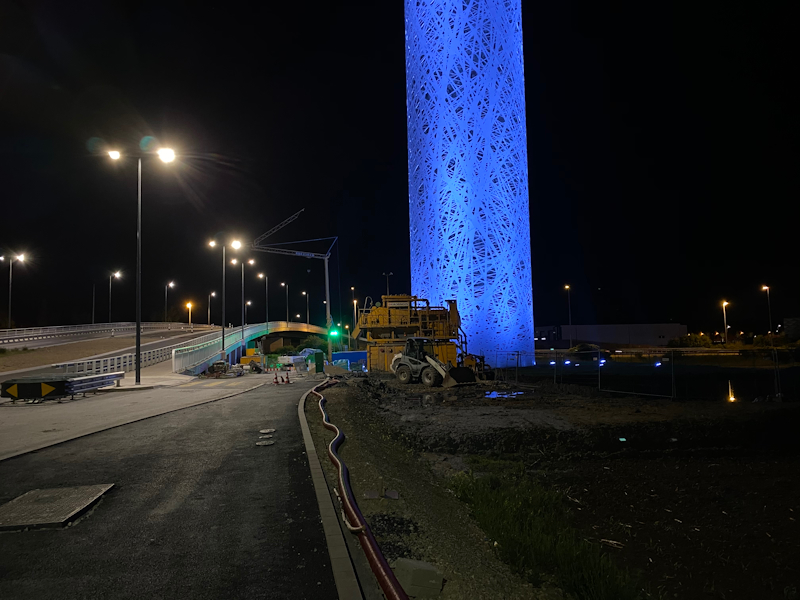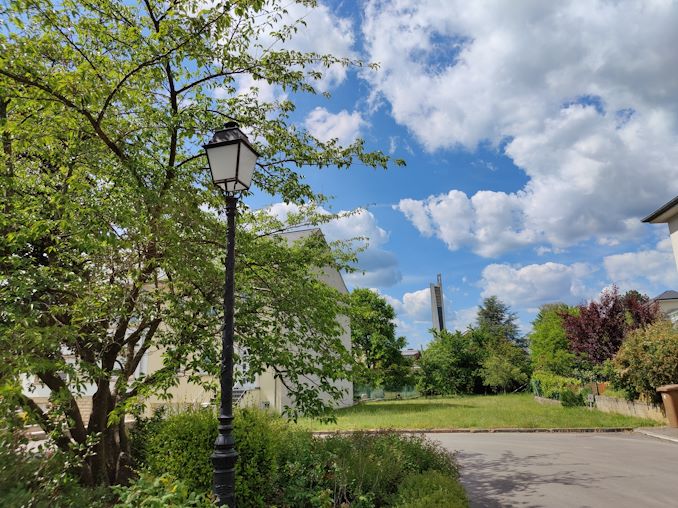The OnePlus 8, OnePlus 8 Pro Review: Becoming The Flagship
by Andrei Frumusanu on June 29, 2020 10:00 AM ESTCamera Recap - Amongst The Best
Last week, we published a more extensive dedicated camera article comparing a larger swath of recent flagship devices that have been released in last few months, including the new OnePlus 8 and OnePlus 8 Pro. I would suggest reading that piece for a more extensive camera analysis of not only the OnePlus 8’s, but also put in better context against its closest competitors:
Read Our Extensive Camera Evaluation For More Samples:
Mobile Flagship Phone Camera Overview 2020 H1: Still Picture Battle
I’ll quickly go over the key characteristics of the two phones in a few samples here:

[ OnePlus 8 ] - [ OnePlus 8 Pro ]
[ iPhone 11 Pro ] - [ iPhone SE ] - [ Pixel 4 ]
[ Galaxy S20U(S) ] - [ Galaxy S20+(E) ]
[ V60 ] - [ Mi 10 Pro ]
[ Mate 30 Pro ] - [ P40 Pro ]
[ Reno3 Pro 5G ] - [ Reno3 Pro ]
[ X-T30 ]
Between the 8 Pro and the regular 8, it’s generally evident that the 8 Pro has the better picture quality thanks to better detail retention and more dynamic range. The phone’s processing is generally amongst the best and competes with Samsung and Apple in terms of handling of tones, although the OnePlus phones more often seem to miss having the better exposure handling, such as in the above scene where both phones are flattening the highlights too much.
In terms of the phones’ main camera 48MP capture modes, it’s the 8 Pro that is the clear winner as the bigger pixels of the superior sensor are able to capture and retain more fine details.
A negative for the phone’s camera processing is that OnePlus continues to apply an artificial darkening filter on the shadows, whilst this increases the contrast of the scenes, it creates unnatural images with elements that nearly clip to black, something that had been introduced last year on the OnePlus 7 Pro as an attempt to copy the Pixel 3’s look – which Google ironically had fixed this aspect on the Pixel 4.

[ OnePlus 8 ]
[ OnePlus 8 Pro ]
[ iPhone 11 Pro ] - [ iPhone SE ] - [ P4 ]
[ Galaxy S20U(S) ]
[ Galaxy S20+(E) ]
[ V60 ]
[ Mi 10 Pro ]
[ Mate 30 Pro ]
[ P40 Pro ]
[ Reno3 Pro 5G ]
[ Reno3 Pro ]
[ X-T30 ]
In terms of telephoto photography, the OnePlus 8 Pro notably is the better phone as it features a dedicated camera module for this task, whilst the OnePlus 8 has to make due with digital cropping, although it’s not as bad thanks to the switch to the camera’s switch to their native 48MP modes.
In the ultra-wide photos, the OnePlus 8 Pro is again the clear winner thanks to its hardware advantages, achieving better details and dynamic range. Both phones are able to showcase good results, although colours aren’t as realistic as on Apple’s and Samsung’s ultra-wides.

[ OnePlus 8 ]
[ OnePlus 8 Pro ]
[ iPhone 11 Pro ] - [ iPhone SE ] - [ Pixel 4 ]
[ Galaxy S20U(S) ]
[ Galaxy S20+(E) ]
[ V60 ]
[ Mi 10 Pro ]
[ Mate 30 Pro ]
[ P40 Pro ]
[ Reno3 Pro 5G ]
[ Reno3 Pro ] - [ X-T30 ]
In low-light photography, OnePlus has been able to make major leaps forward in terms of quality thanks to improved software processing. It’s especially the OnePlus 8 Pro which has the quality lead as the phone’s superior camera sensor showcases a clear advantage to that of the OnePlus 8. In fact, the OnePlus 8 Pro consistently fared as amongst the best performers in low-light photography now, sometimes ending up as the top performer thanks to its excellent new Nightscape implementation.
The 8 Pro’s comparatively large ultra-wide module sensor also means that it’s amongst the best performers in low-light, only being beaten by the even larger sensors of Huawei devices.
One aspect we didn’t cover in our camera comparison article was the OnePlus 8 Pro’s “colour filter camera”. First of all, OnePlus did an absolutely abysmal job in actually describing the technical aspects of this camera and what it actually does. Although switching to this camera module is amongst the colour filter options in the camera UI, its effects are anything but a filter.
Any camera sensor and module on any device out there is able to capture infra-red light by default – it’s just that usually to limit the wavelengths that it sees to that of a human eye, vendors employ an IR blocking filter layer between the camera sensor and the optics. In the OnePlus 8 Pro, this layer is missing, and thus this extra camera module is able to actually capture infrared wavelengths. In fact, hobbyists out there even actively modify their digital cameras to remove this filter to achieve IR photography.
The fact that OnePlus hasn’t been able to explain the technical details of this module in their marketing materials is extremely unfortunate as there’s been a ton of misunderstanding as to what it actually does – even going so far that there’s been a backlash with privacy concerns as the camera can see through some materials that are transparent to IR light but opaque to visible light, with OnePlus even saying they’ll be removing the feature in a software update. I no longer have the phone so I don’t know if it’s actually been disabled or not, but I do find it a pity if it’s gone as it was able to achieve some very unique pictures, especially of vegetation in sunlight.
Read Our Extensive Camera Evaluation For More Samples:
Mobile Flagship Phone Camera Overview 2020 H1: Still Picture Battle
Overall, the OnePlus 8 Pro and OnePlus 8 are both good camera shooters. The regular OnePlus 8 doesn’t convince as much as its hardware disadvantages are clearly limiting what it can achieve. In this regard, the pictures it’s able to produce are adequate but it has trouble compete with the quality of the competition.
The OnePlus 8 Pro is a much better choice if you value the camera experience. OnePlus has made big leaps in the processing and picture quality. In daylight it competes with Apple and Samsung – although I still do think the phone’s shadow handling is too artificial an unrealistic – but that’s a subjective opinion. In low-light, thanks to the new processing and upgraded sensor hardware both on the main sensor and the ultra-wide camera, the OnePlus 8 Pro consistently is amongst the best performers in low-light. Overall, the 8 Pro delivers an excellent camera capture experience that’s plenty versatile.














92 Comments
View All Comments
Dexter101 - Monday, June 29, 2020 - link
I feel like the conclusion leaves out some details on pricing. You can compare the MSRP prices and come to conclusions but in 1 month or so the first big deals will start showing up for Samsung flagships with heavy price drops. You'll be able to get an S20+ for less than 700€ then, while the OnePlus phones stay true to their MSRP pricing year round.Considering the quality control issues, the 200€ you save on the Samsung and the generally less buggy software I would likely go for the S20+, although the Snapdragon in all markets is a good advantage in Europe for Oneplus!
Andrei Frumusanu - Monday, June 29, 2020 - link
I compared it at current street prices - the price drops already happened.PeachNCream - Monday, June 29, 2020 - link
In order to be a flagship, generally said thing should be able to float on water and support fly the fleet commander's flag. I suppose Anandtech tested both of those requirements in order to verify the accuracy of the claim as such for the OnePlus 8, but publishing the benchmark data and testing methods used would be good journalism. Also, pics of the command center from which fleet operations are coordinated inside of the OnePlus 8 would be a nice addition to this review given the high importance of tossing about the term "flagship" in even opening the article.eastcoast_pete - Monday, June 29, 2020 - link
Actually, regarding the ability to float: that is a key problem with many (all?) protective cases! What good does IP68 etc. do me if the damn phone (in its protective case) will still sink to the bottom of whatever body of water one is on or close to? I haven't dropped my phone into the sea yet, but friends of mine have while out fishing. So, any protective cases that will let the $ 1,000 smartphone float?Omair - Monday, June 29, 2020 - link
Hi Andrei, The 8 pro actually supports 10W Qi Wireless Charging, not 5W. You can verify it on the Wireless Power Consortium's Website: https://www.wirelesspowerconsortium.com/products/8...Of course, the charger will need to support Qi's Extended Power Profile to get 10W, which most don't (They usually only support 5W Qi, and then Samsung's and Apple's fast charge above that).
But if the charger is advertised as doing 10W on LG, Sony, or Xiaomi phones, it will most likely do 10W on the 8 pro. You can also just check the charger on the WPC's website and see what wattage is listed.
ads295 - Monday, June 29, 2020 - link
I think we're well past the point where meaningful differences in computing hardware made much difference, such as the jump Samsung made with the Exynos 7420 in the GS6, or the jump from eMMC to UFS storage. Even for screen resolution for a 5.5-6" display, you can't get much better than 1440p at 90Hz. At this point companies should focus ONLY on the differentiating features, such as putting in a huge battery (path breaking to have a thicker phone that last long), better camera (no one has perfected this yet), better phone protection (less snowflake), and other tiny lil goodies such as an IR port, heart rate sensor, SpO² sensor that actually are different.ads295 - Monday, June 29, 2020 - link
But it's as if no one has realised this and people are willing to overpay for LaTeSt CPU BrO and MoAr JiGgAbYtEs and establishing phallic measurements.Alistair - Monday, June 29, 2020 - link
They raised the price on the base model from $700-$800 (depending on launch time frame) to $1100 in Canada. Oneplus is dead. Failed company, a huge disappointment. I finally bought an iPhone for the first time, saved a ton of money. How far Android has fallen in the last 5 years in price and quality is sad.alufan - Monday, June 29, 2020 - link
Agree Android is in trouble, Google has let it down badly by allowing all these suppliers to make so much bloat on handsets after starting with the very first Android and now on a S20 Ultra which frankly is rubbish compared to my mate 30pro I had before I think my next phone will be an Apple, I use one for work and whilst its frustrating due to the lack of or ease of customisation options fact is it just works on Android I have 2 calenders, 2 Music players, 2 browsers, I could go on I want to uninstall the Samsung browser and bixby etc etc but I cant, its my goddam device i want them off but you cant and if I root it then my bank apps no longer work...great way to keep customers GoogleAlistair - Tuesday, June 30, 2020 - link
What is especially worrying is the price bloat. Snapdragon and various Android phone part suppliers seem to be upping their prices dramatically. A Snapdragon 865 should be a lot cheaper and we're hearing rumors they want to charge even more for next year.